I'm pretty sure this hoverfly is Syrphus vitripennis
Its a Batesian mimic of a wasp - ie it shares the warning colours and general apprearance but can't actually defend itself with a sting.
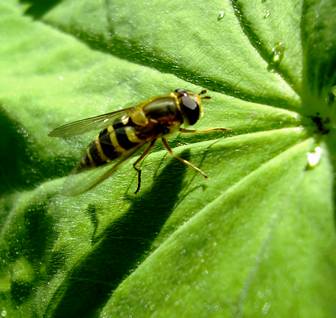
This is a small hoverfly perched on a dandelion flower, but I have no idea which species
 A green bottle fly Phaenicia sericata -they are carrion eaters and lay their eggs in rotting meat or wounds. The maggots can actually be used to clean wounds as they do not eat healthy flesh -though they are rarely used in medicine now.
A green bottle fly Phaenicia sericata -they are carrion eaters and lay their eggs in rotting meat or wounds. The maggots can actually be used to clean wounds as they do not eat healthy flesh -though they are rarely used in medicine now.Their brilliant emerald metallic colours are really pretty.
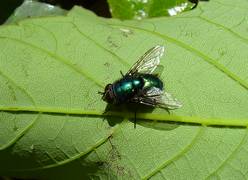
I found quite a few of these bugs- they looked really delicate and graceful. It turns out that they are female scorpion flies Panorpa communis.
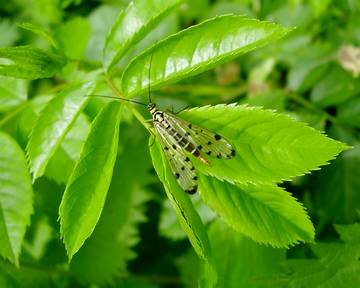 I didn't see any male scorpion flies around- they are more immediately recognisable because they have a curled up 'scorpion sting' which is not in fact venomous -its the male fly's genital area.
I didn't see any male scorpion flies around- they are more immediately recognisable because they have a curled up 'scorpion sting' which is not in fact venomous -its the male fly's genital area.This is another female sitting on some ivy leaves.
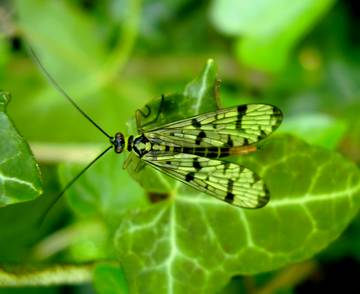
A little black and green bug that I didn't manage to identify. It seemed to be pushing a white thing [an egg?] in the first photo.
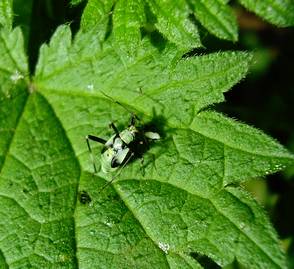
It looks quite like a shield bug but I'm not sure .

A sealed up snail shell - i think its probably Cepaea hortensis
 This is probably the millipede Schizophyllum sabulosum -it has two distinctive pale lines running down its back. They don't actually have thousand legs - just several hundred, with two pairs to each body segement.
This is probably the millipede Schizophyllum sabulosum -it has two distinctive pale lines running down its back. They don't actually have thousand legs - just several hundred, with two pairs to each body segement.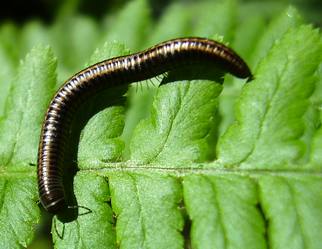
Some cuckoospit on cleavers plant. Cleavers is an interesting plant- we used to call it 'sticky willie'
Tiny hairs on the plant leaves and stem will hook on to clothes and animal fur -and can even just about manage to hook on to skin though not very securely.
We used to pick clumps of it and throw it on each other when we were kids as its stickiness always amused us . We'd also use it to play 'tig' [tag] dn the person who had been tagged with the stckywillie had to peel it off and try and stick it on another victim.
The small ball-like seeds were sticky as well- a useful way of diffusing the plant -and they were harder to remove from clothes than the stems and leaves.
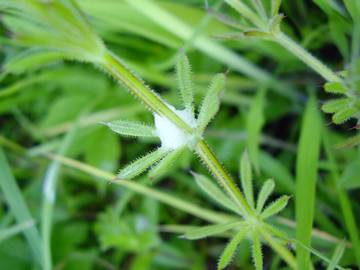
Cuckoo spit [which my kids though was completely gross] is the bubble home of an immature froghopper bug.
The frogghopper produces the froth [cuckoo spit] to hide in and also to prevent its body from drying out. Apparently the 'spit' tastes foul as an additional deterrant for predators [though i've never tried it]
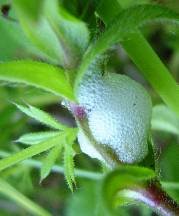 I didn't have the heart to poke through the bubbles and disturb the beastie.
I didn't have the heart to poke through the bubbles and disturb the beastie.
Technorati Tags:
photos
macro
hoverfly
Syrphus vitripennis
Phaenicia sericata
greenbottle
fly
bug
millipede
cleavers
scorpion fly
Panorpa communis
Cepaea hortensis
snail
Schizophyllum sabulosum
froghopper
cuckoo spit











1 comment:
oh no don't disturb the beastie so well hidden in the cuckoospit..nature is so marvellous and you so sweet to open our eyes
thank you
Post a Comment